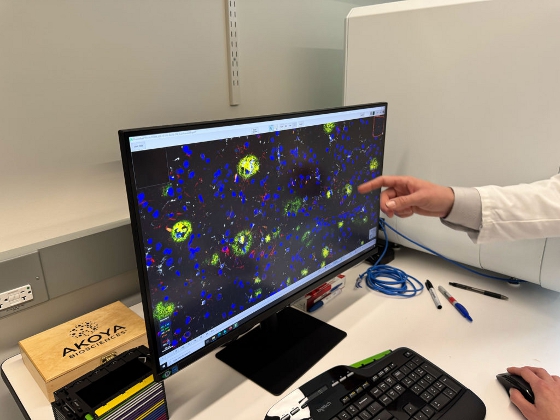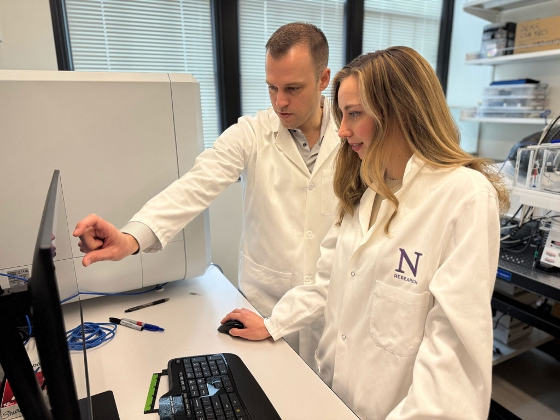 |
| April 22, 2025 | Volume 21 Issue 16 |
Designfax weekly eMagazine
Archives
Partners
Manufacturing Center
Product Spotlight
Modern Applications News
Metalworking Ideas For
Today's Job Shops
Tooling and Production
Strategies for large
metalworking plants
Alzheimer's treatment may lie in kick-starting the brain's own cleanup crew -- early on

A computer image of human brain tissue with Alzheimer's disease that had been treated with amyloid-beta immunization. [Credit: Image courtesy of Northwestern University]
By Kristin Samuelson, Northwestern University
Brain's immune cells cleared plaques, restored a healthier brain environment in immunized patient brains.
For more than three decades, scientists have been racing to stop Alzheimer's disease by removing amyloid beta plaques -- sticky clumps of toxic protein that accumulate in the brain. Now, a new Northwestern Medicine study suggests a promising alternative: enhancing the brain's own immune cells to clear these plaques more effectively.
The findings could reshape the future of Alzheimer's treatments, shifting the focus from simply removing plaques to harnessing the brain's natural defenses.
Earlier attempts at an Alzheimer's vaccine failed when the immune system's response caused dangerous brain swelling. Even today's FDA-approved antibody treatments remain controversial, offering only modest benefits with potential side effects and high price points.
"I think everyone agrees that, although these drugs are becoming more effective, they ultimately do not cure Alzheimer's disease patients," said corresponding author David Gate, PhD, assistant professor in the Ken and Ruth Davee Department of Neurology and director of the Abrams Research Center on Neurogenomics. "These drugs stimulate the immune cells of the brain to remove amyloid beta, but we believe that the data in our publication can be utilized to make these drugs work even better."
The study, published in Nature Medicine, is the first to use a cutting-edge technique called spatial transcriptomics on human clinical-trial brains with Alzheimer's disease. The technique allows scientists to pinpoint the specific spatial location of gene activity inside a tissue sample.

David Gate, PhD (left) and Lynn van Olst, PhD (right) examine a computer image of a treated human brain with Alzheimer's disease. [Credit: Image courtesy of Northwestern University]
By analyzing donated brain tissue from deceased people with Alzheimer's disease who received amyloid-beta immunization and comparing it to those who did not, the scientists found that when these treatments work, the brain's immune cells (called microglia) don't just clear plaques -- they also help restore a healthier brain environment.
But not all microglia are created equal. Some are quite effective at removing plaques, while others struggle, the study found. Also, microglia in treated brains adopt distinct states depending on the brain region and type of immunization. Lastly, certain genes, like TREM2 and APOE, are more active in microglia in response to treatment, helping these cells remove amyloid beta plaques, according to the findings.
"A long-standing question in the field of Alzheimer's therapeutics is if we coax these immune cells into removing the amyloid, are they just always going to be in that amyloid-removal mode?" Gate said. "The answer we found is no, they can remove the amyloid and then go back to being good and appear to actually help the brain heal."
Stopping Alzheimer's "dominoes" from falling
The amyloid cascade hypothesis, the prevailing theory of Alzheimer's disease development, can be compared to a row of dominoes. If amyloid plaques can be cleared from the brain before they trigger the formation of tau pathology -- the key driver of cognitive decline in Alzheimer's patients -- the cascade is halted before it can begin, preventing further damage.
"The idea is that in people who already have Alzheimer's disease, yes, you can maybe remove amyloid, but if the tau spread has been set in motion, you are fighting an uphill battle," Gate said. "But maybe, if you treat people so early that they don't yet have tau pathology, you can stop the domino effect from happening. Our study is the first to identify the mechanisms in microglia, the brain's immune cells, that help limit the spread of amyloid in certain brain regions following treatment with amyloid-targeting drugs.
"If we can define the mechanisms that are associated with clearance of the pathology, and we can find the genetic makeup of immune cells that are associated with people that are really responding well to the drug, then maybe one day we can circumvent the whole drug process and just target these specific cells," Gate said.
Currently, there isn't a way to target these immune cells, Gate said, but methods of targeting cells in the brain are improving year over year.
Published April 2025
Rate this article
View our terms of use and privacy policy
